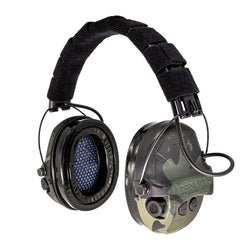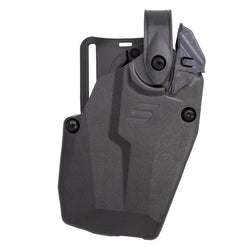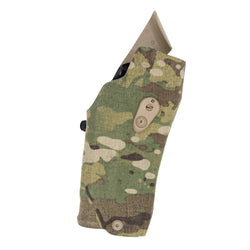How we train must be continuously honed, and techniques must adapt to evolving threats and situations. History has repeatedly shown that real-world events shape the way we train. And many of the most pivotal changes in firearms training stem from lessons learned during high-profile shootouts. These incidents highlight both successes and failures, ultimately driving improvements in tactics, equipment, and mindset.

Let’s take a look at three high-profile historical shootouts that influenced some of the training techniques, equipment, and mindset we use today.
North Hollywood Shootout (February 28, 1997)
You have probably heard of the North Hollywood Shootout before. It involved two heavily armed bank robbers, Larry Phillips Jr. and Emil Mătăsăreanu, who ended up in a gunfight with Los Angeles police officers.
Both men were armed with modified automatic rifles and were using high-capacity drum magazines. They also wore body armor, making them hard to stop.
Back then, police were not issued a lot of gear, and the robbers outgunned and outmatched the responding officers. The shootout lasted nearly 44 minutes, and more than 2,000 rounds were fired.
When a threat is reported to law enforcement today, it’s not uncommon to see officers responding with AR-15 rifles. Back then, however, their firepower consisted of a handgun and shotgun. Imagine trying to stop a person with a shotgun who is wearing body armor and firing an automatic rifle at you…

Officers raided a local gun store taking rifles, and ammo so they could fight back against the gunmen. Ultimately, both suspects were killed, but not before 11 police officers and seven civilians were injured. The incident shocked the nation and exposed significant gaps in law enforcement training and equipment.
Lesson learned: Have more firepower available
The reasoning for agencies to issue patrol rifles to officers involves more than this one event. But there is no question the North Hollywood Shootout heavily influenced the realization that officers need more firepower at their disposal.
This event would influence training techniques for years to come for agencies around the country. One of the most notable outcomes was the adoption of patrol rifles and training programs for them.
While this event did not cause active shooter training to be standard, it did jump-start it. Law enforcement saw the need to be prepared to act quickly against active shooters with rifles. It was not long before AR-15 patrol rifles started being mounted in vehicles where officers could grab them quickly.
Miami-Dade Shootout (April 11, 1986)
The Miami-Dade Shootout is well known within the law enforcement community.
On April 11, 1986, FBI agents were following two suspects in multiple violent crimes and a bank robbery. When they attempted to stop and arrest them, a gun battle broke out.
William Matix and Michael Platt were both military veterans and highly skilled shooters. They were armed with a Mini-14 rifle and multiple semi-automatic firearms.
The FBI agents were equipped primarily with revolvers and shotguns as they attempted to stop the suspects.

Like many deadly incidents, the shootout took place in a short time. In less than five minutes, two FBI agents were killed, five wounded, and both suspects dead. Despite outnumbering the robbers eight to two, the FBI agents were overwhelmed by the robbers’ firepower and determination.
It was a horrible day for law enforcement and is viewed as a major turning point for agencies around the US.
More stopping power and faster reloads
The FBI and other agencies began reevaluating their weaponry and training protocols. One big step the FBI took was to move away from revolvers and start issuing semi-automatic pistols. Their reasoning for this was the need for higher magazine capacities, faster reloading, and more stopping power. One of the two shooters was hit twice but continued to shoot at FBI agents.
This shift influenced police departments nationwide, who also began the selection process of semi-automatic handguns. This is a good example of how slow law enforcement can be to keep equipment up to date. By this point, the famous semi-auto 1911 had been around for more than 70 years and police were still carrying revolvers.

Along with a more modern handgun, a focus on training also became a high priority. This included training in combat shooting under stress, emphasizing accuracy, cover, and the importance of immediate response.
The FBI also developed its firearms qualification standards to ensure agents were better prepared for dynamic and violent encounters.
It can be argued that this event led to nearly all agencies having a firearms qualification program.
Texas Tower Sniper Incident (August 1, 1966)
Just about everyone has heard of Charles Whitman, the Texas Tower Sniper. When Whitman killed 16 people and wounded 31 others, it was the largest mass shooting by a single shooter in US history.
Whitman had also stabbed his wife and mother before climbing the tower at the University of Texas and opening fire.
Whitman was a former US Marine, who at the age of 25, was an expert shot. He used a Remington 700 along with multiple other guns to shoot from the tower. Armed with a small arsenal, Whitman spent 96 minutes firing from his elevated position before being stopped by police and armed civilians.

The incident was one of the earliest mass shootings in modern U.S. history and exposed the challenges of responding to a shooter with a tactical advantage. Police officers, lacking proper equipment and training for such situations, initially struggled to approach and neutralize the threat.
In the photo above, a young girl hid behind a bell while another lay behind the bushes for more than 90 minutes during the shooting at the University of Texas Tower. Both students survived the incident.
How did this influence our training?
Sadly, this incident marked the beginning of a slew of active shooter events across our nation. Like several other events, the Texas Tower shooting resulted in agencies seeing the need for active shooter training. This training was nothing compared to today’s training, but another step along the way.
It also started a movement of schools realizing the need for better security, notification systems, and active shooter training for students.

Police departments began developing specialized tactics for dealing with heavily armed assailants in elevated or fortified positions. The use of scoped rifles by law enforcement became standard practice, with sniper units being created in many departments.
The Texas Tower Sniper Incident also paved the way for the creation of SWAT (Special Weapons and Tactics) teams, which are trained to respond to complex and high-risk scenarios. These teams now receive extensive training in urban combat, sniper tactics, and coordination with other agencies during crises.
Training is a never-ending process
Historical shootouts have played a major role in shaping firearms training over the years. They serve as a sobering reminder of the unpredictable and dangerous realities that exist today. Most of our modern training today is based on evaluation and reviews of multiple incidents throughout history.
While correct training, equipment, and preparedness were not achieved from any one event, we have come a long way.
Take active shooter training for instance. Officers were taught to set up a barricade and wait for appropriate backup before approaching the shooter. After years of learning from past incidents, we now train officers to immediately engage the shooter when they arrive on scene.
We will no doubt continue to learn and improve how we train, prepare, and respond to incidents. This is no different for those who carry concealed for self-defense.
The training you receive is based on incidents of the past. So, make sure your training is up to date and continue to prepare for the worst as you hope for the best.











